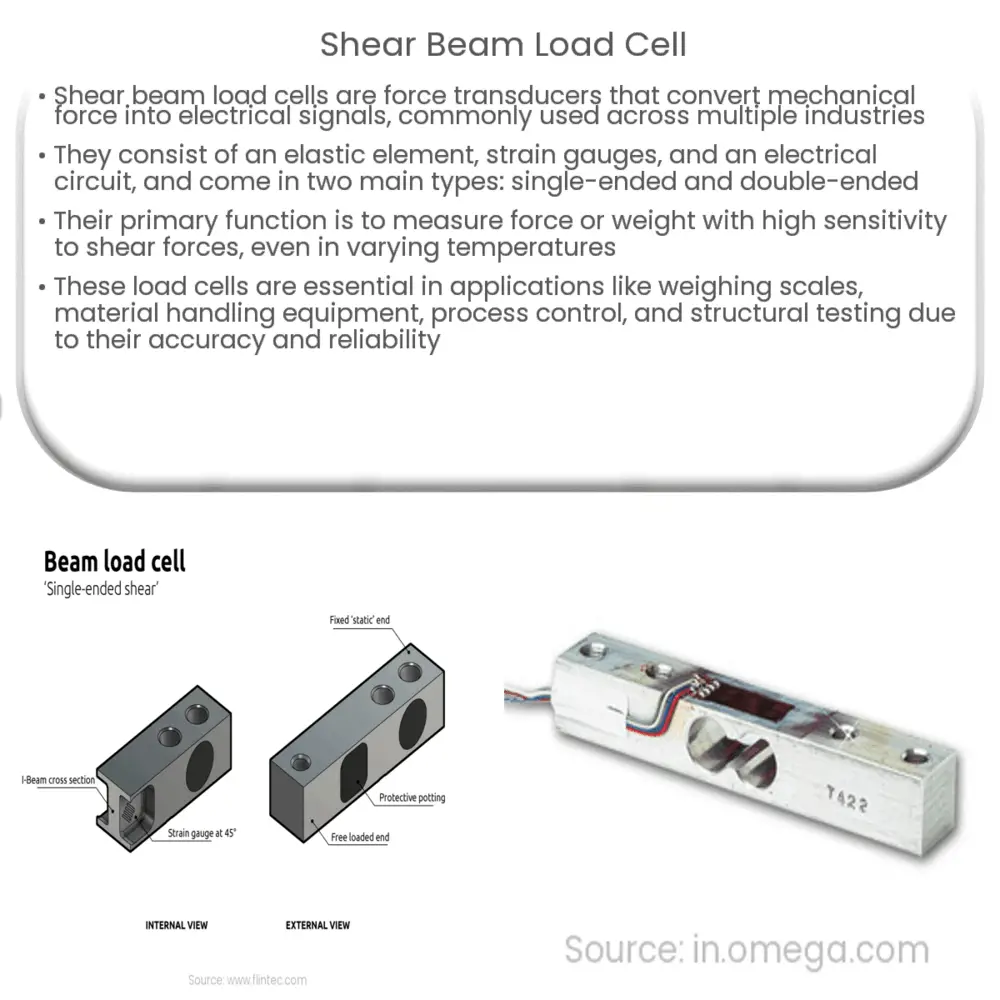Shear beam load cells are force transducers that convert mechanical deformation into electrical signals for accurate weight and force measurement.

Shear Beam Load Cell: An In-Depth Look at Its Design, Function, and Applications
Introduction
Shear beam load cells are a popular type of force transducer used for measuring weight and force in various industries. They provide an accurate and reliable means of converting mechanical force into an electrical signal. In this article, we will explore the design, function, and applications of shear beam load cells in greater detail.
Design of Shear Beam Load Cells
Shear beam load cells consist of an elastic element, strain gauges, and an electrical circuit. The elastic element is typically made of high-quality steel or alloy and is designed to deform when subjected to force. This deformation creates strain, which is sensed by the strain gauges attached to the elastic element. The strain gauges are piezoresistive devices that change their electrical resistance in response to mechanical strain. The electrical circuit processes the change in resistance and outputs a signal proportional to the applied force.
There are two main types of shear beam load cells: single-ended and double-ended. Single-ended shear beam load cells have one fixed end and one loading end, while double-ended shear beam load cells have both ends fixed and load applied in the middle. The choice between these two types depends on the specific application and desired performance characteristics.
Function of Shear Beam Load Cells
The primary function of a shear beam load cell is to measure force or weight by converting mechanical deformation into an electrical signal. When a load is applied to the elastic element, it deforms and creates strain on the strain gauges. The strain gauges, in turn, change their electrical resistance, which is detected by the electrical circuit. The change in resistance is proportional to the applied force, allowing the load cell to provide a highly accurate and repeatable measurement.
Shear beam load cells are designed to be highly sensitive to shear forces, which are forces acting parallel to the plane of the elastic element. This sensitivity allows them to accurately measure the applied load, even in the presence of other forces, such as bending or torsional forces. Additionally, shear beam load cells often feature temperature compensation to maintain accuracy over a wide range of operating temperatures.
Applications of Shear Beam Load Cells
Due to their accuracy, reliability, and versatility, shear beam load cells find applications in various industries. Some of the most common applications include:
- Weighing scales: Shear beam load cells are widely used in industrial weighing scales for measuring the weight of raw materials, finished goods, and containers.
- Material handling equipment: Load cells are often integrated into material handling equipment, such as forklifts and cranes, to ensure safe and efficient operation.
- Process control: In manufacturing and processing industries, shear beam load cells are used to monitor and control material flow, batch weighing, and inventory management.
- Structural testing: Load cells are used in structural testing applications to measure the forces acting on buildings, bridges, and other structures, ensuring their safety and integrity.
Advantages of Shear Beam Load Cells
Shear beam load cells offer numerous advantages that make them suitable for various applications. Some of the key benefits include:
- Accuracy: Shear beam load cells provide high accuracy and repeatability, making them ideal for applications requiring precise force or weight measurements.
- Reliability: Due to their robust design and construction, shear beam load cells exhibit long service life and excellent stability, ensuring reliable performance over time.
- Low-profile: The compact and low-profile design of shear beam load cells allows for easy integration into various systems and equipment, minimizing space requirements.
- Overload protection: Shear beam load cells often feature built-in overload protection, which prevents damage and maintains accuracy even when subjected to excessive loads.
- Environmental resistance: With temperature compensation and corrosion-resistant materials, shear beam load cells can operate effectively in a wide range of environmental conditions.
Selection Considerations
When choosing a shear beam load cell for a specific application, several factors should be considered to ensure optimal performance and compatibility. These factors include:
- Capacity: Select a load cell with an appropriate capacity for the intended application, ensuring that it can handle the maximum expected force or weight without overloading.
- Accuracy: Consider the required accuracy for the application and choose a load cell with an appropriate accuracy class to meet those requirements.
- Mounting: Determine the ideal mounting configuration, such as single-ended or double-ended, based on the specific requirements of the application and available space.
- Environmental conditions: Evaluate the operating environment, including temperature, humidity, and potential exposure to corrosive substances, and select a load cell with suitable environmental protection.
- Output signal: Choose a load cell with a compatible output signal, such as voltage or current, to ensure seamless integration with existing control systems and instrumentation.
Conclusion
Shear beam load cells are versatile and reliable force transducers that find widespread use in various industries due to their high accuracy, robust design, and low-profile construction. With applications ranging from weighing scales and material handling equipment to process control and structural testing, shear beam load cells are an essential component in many measurement and control systems. By carefully considering the factors discussed in this article, you can select the ideal shear beam load cell for your specific application, ensuring accurate and dependable performance.

